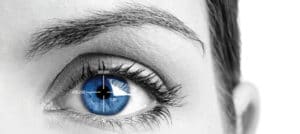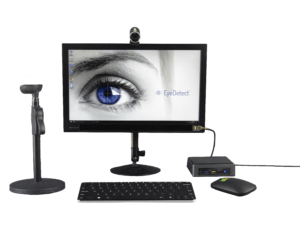Accurate Lie Detection
EyeDetect can see through lies by analyzing eye behavior.
The science team that invented the computerized polygraph developed EyeDetect. Our science team includes the world’s foremost experts on polygraph techniques.
For almost a century, the polygraph has been the only viable solution for lie detection, but after 12 years of research, our scientists have developed an equally effective solution that can be used with polygraph or as an alternative, in appropriate applications.

How Does Lying Affect the Body?
Lying causes subtle changes in the behavior of the eye due to increased cognitive load.
EyeDetect uses a precision optical scanner to measure these changes and specialized algorithms to create a credibility score. The polygraph measures emotional responses to questions; EyeDetect evaluates changes in cognitive load associated with deception.
Deception is more cognitively demanding than being truthful. First, deceptive thinking requires planning, comparison, and execution of purposefully incorrect responses. The extra vigilance required by deception results in increased cognitive workload, which is reflected in increased question response errors, increased question response time, and an increase in overall reading and re-reading time.
Second, deception requires caution and strategy. As such, general indices of processing difficulty such as question response time, pupil diameter, and number of fixations while reading, as well as initial and delayed processing difficulty when taking a first pass and then a second¬ when reading are affected.
The two technologies can provide partially independent sources of diagnostic information about truth and may be used in combination to great advantage in some applications.
How Does EyeDetect Work?
The person being tested sits in front of a computer and uses a chin rest to stabilize his or her head.
After being calibrated to the optical scanner, the person answers a series of true/false questions.
The question responses, along with pupillary changes and eye movements are measured and are stored on a secure, encrypted data locker.
At the conclusion of the test, the data are uploaded to a secure cloud server where it is analyzed and a detailed report is then generated. In essence, by means of a logistic regression equation, EyeDetect computes the probability of truthfulness.
Only authorized personnel can access the report through a Web browser or mobile device to view individual tests and the Converus Credibility Score. This score is the probability that the person was truthful.

A subject answers T and F questions appearing on a computer screen while the optical scanner photographs changes in the eyes (pupil diameter, blink rate, gaze position, etc.)
During the test, the persons’s responses and the data captured by the optical scanner are encrypted and stored on a secure data locker.
Data are sent to the secure cloud, where proprietary algorithms interpret the data and provide a report with the person’s responses and a Converus Credibility Score (and both are accessible by authorized personnel from any Web browser.)
Practical Lie Detection
“The polygraph is ideal for crime-specific incidents. But because of cost, invasiveness, training and upkeep, it can’t be used on a large scale. With EyeDetect, those costs can be reduced significantly. It’s non-invasive, quick, and results are immediate. It helps companies hire and keep honest people.”

Interested?




